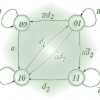Free Online Productivity Tools
i2Speak
i2Symbol
i2OCR
iTex2Img
iWeb2Print
iWeb2Shot
i2Type
iPdf2Split
iPdf2Merge
i2Bopomofo
i2Arabic
i2Style
i2Image
i2PDF
iLatex2Rtf
Sci2ools
224
click to vote
Book
An Exploration of Random Processes for Engineers
"From an applications viewpoint, the main reason to study the subject of these notes is to help deal with the complexity of describing random, time-varying functions. A random variable can be interpreted as the result of a single measurement. The distribution of a single random variable is fairly simple to describe. It is completely speci
ed by the cumulative distribution function F(x), a function of one variable. It is relatively easy to approximately represent a cumulative distribution function on a computer."
Expectation Mximization (EM) Algorithm | Hidden Markov Models | Martingales | Mathematics | Random Processes | Wiener |
Related Content
| Added | 04 Mar 2009 |
| Updated | 04 Mar 2009 |
| Authors | Bruce Hajek |
Table of Content
1.1 The axioms of probability theory1.2 Independence and conditional probability
1.3 Random variables and their distribution
1.4 Functions of a random variable
1.5 Expectation of a random variable
1.6 Frequently used distributions
1.7 Jointly distributed random variables
1.8 Cross moments of random variables
1.9 Conditional densities
1.10 Transformation of random vectors
1.11 Problems
2.1 Four definitions of convergence of random variables
2.2 Cauchy criteria for convergence of random variables
2.3 Limit theorems for sequences of independent random variables
2.4 Convex functions and Jensen's inequality
2.5 Chernoff bound and large deviations theory
2.6 Problems
3.1 Basic definitions and properties
3.2 The orthogonality principle for minimum mean square error estimation
3.3 Conditional expectation and linear estimators
3.3.1 Conditional expectation as a projection
3.3.2 Linear estimators
3.3.3 Discussion of the estimators
3.4 Joint Gaussian distribution and Gaussian random vectors
3.5 Linear Innovations Sequences
3.6 Discrete-time Kalman filtering
3.7 Problems
4.1 Definition of a random process
4.2 Random walks and gambler's ruin
4.3 Processes with independent increments and martingales
4.4 Brownian motion
4.5 Counting processes and the Poisson process
4.6 Stationarity
4.7 Joint properties of random processes
4.8 Conditional independence and Markov processes
4.9 Discrete-state Markov processes
4.10 Space-time structure of discrete-state Markov processes
4.11 Problems
5.1 A bit of estimation theory
5.2 The expectation-maximization (EM) algorithm
5.3 Hidden Markov models
5.3.1 Posterior state probabilities and the forward-backward algorithm
5.3.2 Most likely state sequence { Viterbi algorithm
5.3.3 The Baum-Welch algorithm, or EM algorithm for HMM
5.4 Notes
5.5 Problems
6.1 Examples with finite state space
6.2 Classification and convergence of discrete-time Markov processes
6.3 Classification and convergence of continuous-time Markov processes
6.4 Classification of birth-death processes
6.5 Time averages vs. statistical averages
6.6 Queueing systems, M/M/1 queue and Little's law
6.7 Mean arrival rate, distributions seen by arrivals, and PASTA
6.8 More examples of queueing systems modeled as Markov birth-death processes
6.9 Foster-Lyapunov stability criterion and moment bounds
6.9.1 Stability criteria for discrete-time processes
6.9.2 Stability criteria for continuous time processes
6.10 Problems
7.1 Continuity of random processes
7.2 Mean square differentiation of random processes
7.3 Integration of random processes
7.4 Ergodicity
7.5 Complexification, Part I
7.6 The Karhunen-Loeve expansion
7.7 Periodic WSS random processes
7.8 Problems
8.1 Basic definitions
8.2 Fourier transforms, transfer functions and power spectral densities
8.3 Discrete-time processes in linear systems
8.4 Baseband random processes
8.5 Narrowband random processes
8.6 Complexification, Part II
8.7 Problems
9.1 Return of the orthogonality principle
9.2 The causal Wiener filtering problem
9.3 Causal functions and spectral factorization
9.5 Discrete time Wiener filtering
9.6 Problems
10.1 Conditional expectation revisited
10.2 Martingales with respect to filtrations
10.3 Azuma-Hoeffding inequaltity
10.4 Stopping times and the optional sampling theorem
10.5 Notes
10.6 Problems
11.1 Some notation
11.2 Convergence of sequences of numbers
11.3 Continuity of functions
11.4 Derivatives of functions
11.5 Integration
11.5.1 Riemann integration
11.5.2 Lebesgue integration
11.5.3 Riemann-Stieltjes integration
11.5.4 Lebesgue-Stieltjes integration
11.6 On the convergence of the mean
11.7 Matrices
Comments (0)



